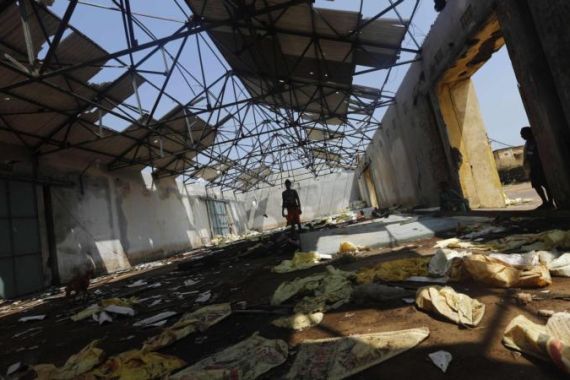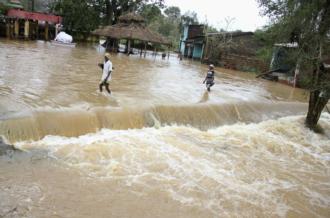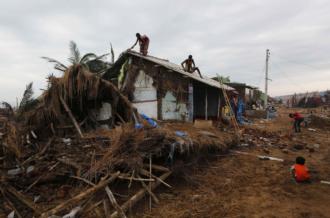Misery mounts in Cyclone Phailin’s wake
Indian states of Odisha and Andhra Pradesh reel from floods two weeks after powerful storm struck eastern coast.

Narayan Moharana is trying hard to salvage some utensils from a pile of rubble of what used to be his house till a fortnight ago.
“It’s all over for us,” says the resident of Katuri village in Ganjam district of the eastern Indian state of Odisha.
Keep reading
list of 4 itemsLost Futures
Photos: Greek valley that became a lake stirs drought debate
Botswana threatens to send 20,000 elephants to Germany
Penury stares Moharanain in the face in the aftermath of Cyclone Phailin.
The storm, packing winds up to 240km per hour that struck India’s eastern coast early this month, has left thousands like Moharana adrift on a sea of hopelessness.
The most ferocious storm to have hit this part of the world in recent history was not as deadly as it was originally feared. The storm and the accompanying rain left 45 dead in Odisha.
Authorities had managed to evacuate more than a million people living on the coast to safe houses, thereby averting a high death toll.
But large-scale destruction in the face of the powerful storm that dumped heavy rains and prompted rivers to overflow was unavoidable. And two weeks later, the states of Odisha and Andhra Preadesh are still reeling.
“Death or no death, it has been a gigantic disaster,” Chief Minister Naveen Patnaik, Odisha’s highest elected official, said.
By official accounts, more than half of Odisha’s 42 million population have been affected by the cyclone and the resulting floods, 800,000 houses damaged and standing crop over 860,000 hectares damaged.
Over 2,600,000 trees and several hundred thousand fruit-bearing trees have been uprooted.
The destruction to infrastructure has also been staggering: more than 210,000 electric poles and over 90 electrical towers have been severely damaged, leading to power outages.
 |
The Cyclone damaged 800,000 houses in Odisha state [Reuters] |
In neighbouring Andhra Pradesh,which experienced heavy rains even last week, 53 people have died and more than 42,000 houses damaged due to flooding.
Officials estimate that over 15 percent of the crop – including paddy and cotton, the two major produce of the state – have suffered permanent damage.
Communication remains badly hit with more than 5,000 km of roads damaged. Train movement remains severely disrupted, with swollen rivers flooding railway tracks.
Continuing rains are piling further misery on the region.
In October, it rained 300 percent more in Odisha than the average. The rains left another 15 dead even as houses already damaged by the cyclone suffered more battering.
“The rains have come as a double whammy for Orissa. The scale of damage and devastation due to the cyclone and floods would be the biggest in state’s history,” said PK Mohapatra, Odisha’s special relief commissioner.
“It even exceeded the devastation that the state suffered during the 1999 super cyclone when close to 10,000 people died.”
In the immediate aftermath of the cyclone, the authorities had won praise for succeeding in keeping the death toll low. Even the UN commended the government of Odisha for its efforts.
But two weeks on, its goodwill is fast evaporating as the floods stretch its resources and millions remain marooned awaiting relief.
In Gopalpur – where Phailin made its landfall – power is yet to be restored.
 |
| The storm left 45 people dead in Odisha state [Reuters] |
“The available resources may not be enough to rebuild the homes and livelihoods of the people. We need a massive effort and lots of money to get people rebuild their lives,” Krishan Kumar, district collector of Ganjam, says.
“It would take months.”
“I have never seen so much devastation in my life. Homes which were partially damaged have now collapsed fully,” said Debabrata Patra of Action Aid. Ironically, the brightest side of the cyclone story – its low death count – has also meant that media interest tapered off even before the full extent of the destruction was clear.
It is little surprise that aid for relief and reconstruction has been slow in coming.
The federal government in New Delhi has sent teams to assess the damage and decide on aid, while voluntary agencies are finalising their own assessment reports for sending them to Western donors.
The Odisha government has demanded Rs 6,000 crores ($975m) as immediate assistance though the actual damage could be five times more.
Stranded on rooftops and whatever higher ground they could find, they reacted in horror when told that a local official planned to deploy a much-sought-after helicopter in an attempt to dry up a soggy field for hosting the India-Australia cricket match.
That a section of the local media ignored their hungry plight and chose to attend a cocktail dinner for a visiting celebrity sportswoman did not amuse them either.